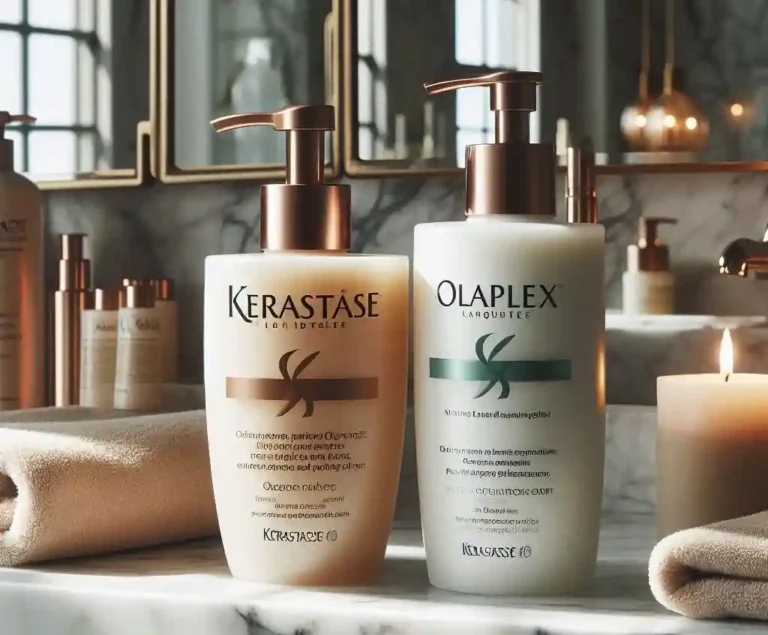Wellaplex vs Olaplex – Which Treatment is Right for You?
Wellaplex vs Olaplex – When it comes to hair repair, there are many options on the market, but two products stand out from the rest: Wellaplex and Olaplex.
Both products have gained a loyal following among hairstylists and at-home users alike, but which one is truly the best?
In this comparison, we’ll delve into the features, benefits, and drawbacks of each product to help you make an informed decision about which one is right for your hair type and needs.
Wellaplex vs Olaplex – A Quick Comparison

| Feature | Wellaplex | Olaplex |
|---|---|---|
| Product Type | Nourishing, moisturizing treatment | Bond-building treatment |
| Hair Type | Suitable for dry, damaged, and processed hair | Suitable for over-processed, broken, and fragile hair |
| Key Ingredients | Keratin amino acids, hydrolyzed wheat protein | Patented bond-building technology |
| Application | At-home treatment, salon treatment | At-home treatment, salon treatment |
| Price | 20-30 | 50-100 |
| Availability | Online, in-store | Online, in-store |
| Salon Availability | Yes | Yes |
| Color Safe | Yes | Yes |
| Virgin Hair | Yes | Yes |
What Are Wellaplex and Olaplex: Understanding the Basics
Wellaplex: The New Kid on the Block
Wellaplex is a relatively new player in the hair care industry, but it’s quickly gaining popularity among hairstylists and hair enthusiasts alike. Developed by a team of experts in the field of hair science, Wellaplex is a bond-building treatment designed to repair and restore damaged hair.
It’s formulated with a unique blend of ingredients that target the hair’s internal structure, rebuilding and strengthening bonds to leave hair feeling soft, smooth, and looking vibrant.
Olaplex: The Original Bond-Builder
Olaplex, on the other hand, is a well-established brand that has been a game-changer in the hair industry. Founded in 2014, Olaplex has become synonymous with hair repair and protection.
Its patented technology is based on a single active ingredient, Bis-Aminopropyl Diglycol Dimaleate, which is responsible for rebuilding and restoring broken bonds in the hair. Olaplex has become a staple in many salons and is widely used by hairstylists and at-home users alike.
Key Ingredients: A Breakdown of Wellaplex and Olaplex Formulations

Wellaplex: A Blend of Nourishing Ingredients
Wellaplex’s unique formula is built around a blend of nourishing ingredients, including:
- Keratin Amino Acids: These amino acids help to repair and rebuild the hair’s protein structure, leaving it stronger and more resilient.
- Hydrolyzed Wheat Protein: This ingredient helps to repair and restore the hair’s natural moisture barrier, leaving it soft, smooth, and manageable.
- Argania Spinosa Kernel Oil: Rich in antioxidants and essential fatty acids, this ingredient helps to nourish and protect the hair, leaving it looking healthy and vibrant.
- Glycerin: This humectant helps to lock in moisture, leaving the hair feeling soft, smooth, and supple.
Olaplex: The Power of Bis-Aminopropyl Diglycol Dimaleate
Olaplex, on the other hand, is built around a single, patented ingredient:
- Bis-Aminopropyl Diglycol Dimaleate: This unique ingredient is responsible for rebuilding and restoring broken bonds in the hair, leaving it stronger, more resilient, and more resistant to damage.
How They Work: A Comparison of Wellaplex and Olaplex Mechanisms
Wellaplex: A Multi-Faceted Approach to Hair Repair
Wellaplex’s unique formula works on multiple levels to repair and restore damaged hair. Here’s how:
- Keratin Repair: Wellaplex’s keratin amino acids help to repair and rebuild the hair’s protein structure, filling in gaps and cracks in the hair shaft.
- Moisture Locking: The hydrolyzed wheat protein and glycerin in Wellaplex help to lock in moisture, leaving the hair feeling soft, smooth, and supple.
- Antioxidant Protection: The argania spinosa kernel oil in Wellaplex provides antioxidant protection, shielding the hair from environmental stressors and damage.
Olaplex: The Bond-Building Powerhouse
Olaplex, on the other hand, works through a single, patented mechanism:
- Bond-Building: Olaplex’s Bis-Aminopropyl Diglycol Dimaleate ingredient works to rebuild and restore broken bonds in the hair, repairing damage at the molecular level.
Hair Types and Needs: Which Product is Best for You?

Wellaplex: Ideal for Dry, Damaged, and Processed Hair
Wellaplex is an excellent choice for:
- Dry and brittle hair: Wellaplex’s nourishing ingredients help to lock in moisture, leaving dry hair feeling soft and supple.
- Damaged hair: Wellaplex’s keratin amino acids and hydrolyzed wheat protein help to repair and rebuild the hair’s protein structure.
- Processed hair: Wellaplex’s antioxidant-rich formula helps to protect hair from environmental stressors and damage.
Olaplex: Ideal for Over-Processed, Broken, and Fragile Hair
Olaplex is an excellent choice for:
- Over-processed hair: Olaplex’s bond-building technology helps to repair and restore broken bonds, leaving hair stronger and more resilient.
- Broken hair: Olaplex’s patented ingredient helps to rebuild and restore broken bonds, repairing damage at the molecular level.
- Fragile hair: Olaplex’s gentle, non-stripping formula helps to repair and protect fragile hair, leaving it feeling soft and looking healthy.
Application and Processing: A Comparison of Wellaplex and Olaplex Methods
Wellaplex: A Simple, At-Home Application
Wellaplex is designed for at-home use, making it easy to incorporate into your regular hair care routine. Here’s how to apply Wellaplex:
- Shampoo and towel-dry hair: Start by washing your hair with a clarifying shampoo and towel-drying it until it’s damp.
- Apply Wellaplex: Apply the Wellaplex treatment to your hair, focusing on the ends and mid-lengths.
- Leave on for 10-15 minutes: Allow the treatment to process for 10-15 minutes, depending on the level of damage and desired results.
- Rinse and condition: Rinse the treatment out of your hair and follow up with a moisturizing conditioner.
Olaplex: A Professional-Grade Treatment
Olaplex, on the other hand, is typically applied in a salon setting by a professional stylist. Here’s how Olaplex is typically applied:
- Consultation and preparation: Your stylist will consult with you to determine the best course of treatment and prepare your hair for the Olaplex application.
- Apply Olaplex: The Olaplex treatment is applied to your hair, focusing on the areas that need the most repair.
- Processing time: The treatment is left on for a specified amount of time, depending on the level of damage and desired results.
- Rinse and tone: The treatment is rinsed out of your hair, and a toner may be applied to enhance the color and shine of your hair.
Results and Benefits: What to Expect from Wellaplex and Olaplex
Wellaplex: Soft, Smooth, and Manageable Hair
With Wellaplex, you can expect:
- Soft and smooth hair: Wellaplex’s nourishing ingredients help to lock in moisture, leaving hair feeling soft and smooth to the touch.
- Manageable hair: Wellaplex’s keratin amino acids and hydrolyzed wheat protein help to repair and rebuild the hair’s protein structure, making it more manageable and easier to style.
- Reduced frizz and flyaways: Wellaplex’s antioxidant-rich formula helps to smooth the hair cuticle, reducing frizz and flyaways for a sleeker, more polished look.
Olaplex: Strong, Resilient, and Vibrant Hair
With Olaplex, you can expect:
- Strong and resilient hair: Olaplex’s bond-building technology helps to repair and restore broken bonds, leaving hair stronger and more resilient.
- Vibrant color and shine: Olaplex’s patented ingredient helps to repair and protect the hair’s color and shine, leaving it looking vibrant and healthy.
- Reduced breakage and split ends: Olaplex’s bond-building technology helps to repair and restore broken bonds, reducing breakage and split ends for healthier-looking hair.
Price and Availability: A Comparison of Wellaplex and Olaplex Costs
Wellaplex: Affordable and Accessible
Wellaplex is generally priced between 20-30 for a single treatment, making it an affordable and accessible option for those looking to repair and protect their hair.
- At-home treatment: Wellaplex is available for purchase online and in-store at various retailers, making it easy to incorporate into your regular hair care routine.
- Salon treatment: Wellaplex is also available as a salon treatment, with prices varying depending on the salon and location.
Olaplex: Professional-Grade Repair
Olaplex, on the other hand, is generally priced between 50-100 for a single treatment, making it a more premium option for those looking for a professional-grade hair repair treatment.
- Salon treatment: Olaplex is typically available as a salon treatment, with prices varying depending on the salon and location.
- At-home treatment: Olaplex is also available for purchase online and in-store at various retailers, but it’s recommended to use it under the guidance of a professional stylist.
The Verdict: Which Product Reigns Supreme in the World of Hair Repair?
Wellaplex: A Solid Choice for Hair Repair
Wellaplex is a solid choice for those looking for a nourishing, moisturizing treatment that can help repair and protect hair. Its unique blend of ingredients, including keratin amino acids and hydrolyzed wheat protein, make it an excellent option for hair that’s dry, damaged, or processed.
Olaplex: The Gold Standard of Hair Repair
Olaplex, on the other hand, is the gold standard of hair repair. Its patented bond-building technology makes it an unparalleled option for hair that’s severely damaged, broken, or fragile. With its ability to repair and restore broken bonds, Olaplex is the go-to choice for those who want to achieve salon-quality results at home.
FAQs
Q: What is the main difference between Wellaplex and Olaplex?
A: The main difference between Wellaplex and Olaplex is their approach to hair repair. Wellaplex is a nourishing, moisturizing treatment that focuses on repairing and protecting hair, while Olaplex is a bond-building treatment that focuses on repairing and restoring broken bonds.
Q: Which product is better for dry, damaged hair?
A: Wellaplex is generally better suited for dry, damaged hair, as it provides a nourishing, moisturizing treatment that helps to repair and protect hair.
Q: Which product is better for over-processed hair?
A: Olaplex is generally better suited for over-processed hair, as it provides a bond-building treatment that helps to repair and restore broken bonds.
Q: Can I use both Wellaplex and Olaplex?
A: Yes, you can use both Wellaplex and Olaplex, depending on your hair type and needs. Wellaplex is a great option for nourishing and moisturizing hair, while Olaplex is a great option for repairing and restoring broken bonds.
Q: Are Wellaplex and Olaplex suitable for all hair types?
A: Yes, both Wellaplex and Olaplex are suitable for all hair types, including dry, damaged, over-processed, and fragile hair.
Q: Can I use Wellaplex and Olaplex together?
A: Yes, you can use Wellaplex and Olaplex together, depending on your hair type and needs. Wellaplex can be used as a pre-treatment to nourish and moisturize hair, while Olaplex can be used as a post-treatment to repair and restore broken bonds.
Q: Are Wellaplex and Olaplex available in salons?
A: Yes, both Wellaplex and Olaplex are available in salons, and can be used as a professional treatment or at-home treatment.
Q: Can I use Wellaplex and Olaplex on colored hair?
A: Yes, both Wellaplex and Olaplex can be used on colored hair, but it’s recommended to do a strand test first to ensure the product doesn’t affect the color or tone of your hair.
Q: Can I use Wellaplex and Olaplex on virgin hair?
A: Yes, both Wellaplex and Olaplex can be used on virgin hair, but it’s recommended to do a strand test first to ensure the product doesn’t affect the natural texture or porosity of your hair.

Hi, I’m Rachel Powell, the founder and creative mind behind FashionBeautyLooks.com. With a passion for all things fashion and beauty, I’ve dedicated my career to helping others discover their unique style and enhance their natural beauty.







